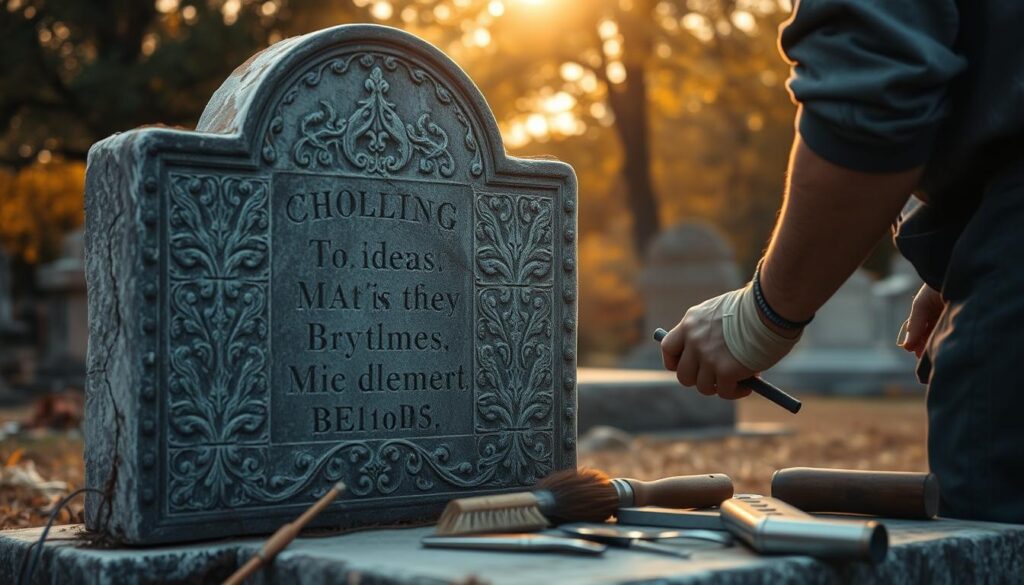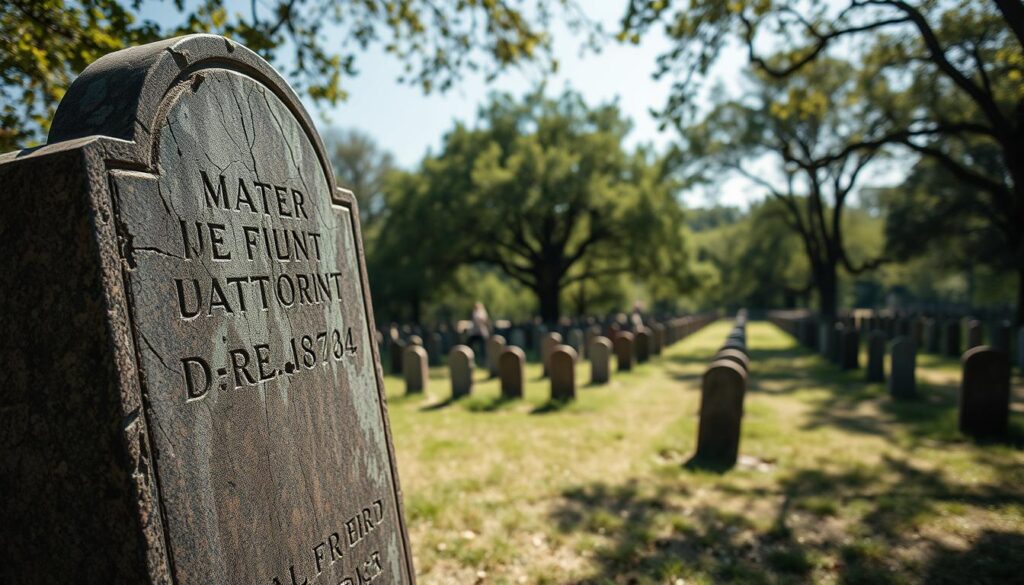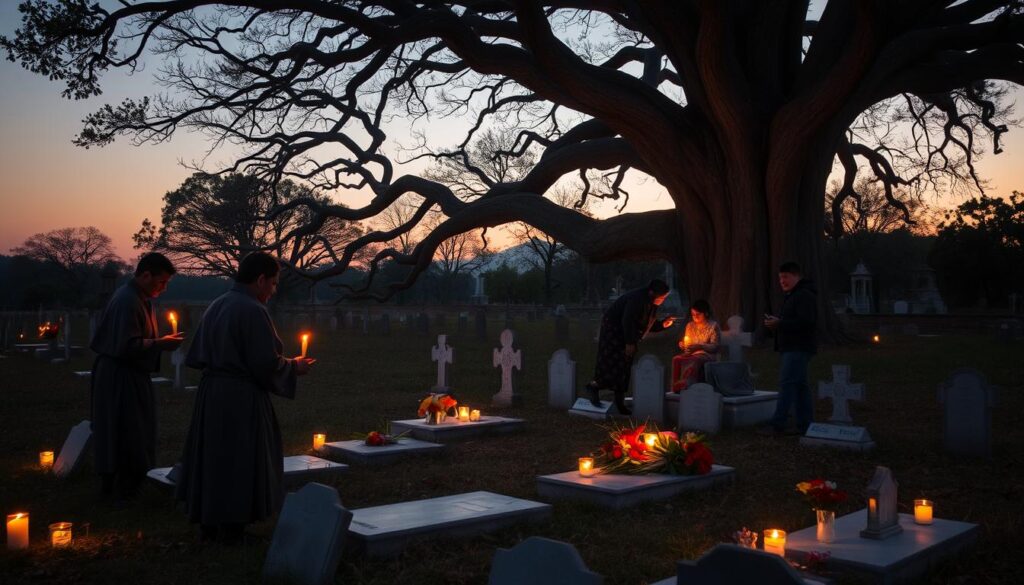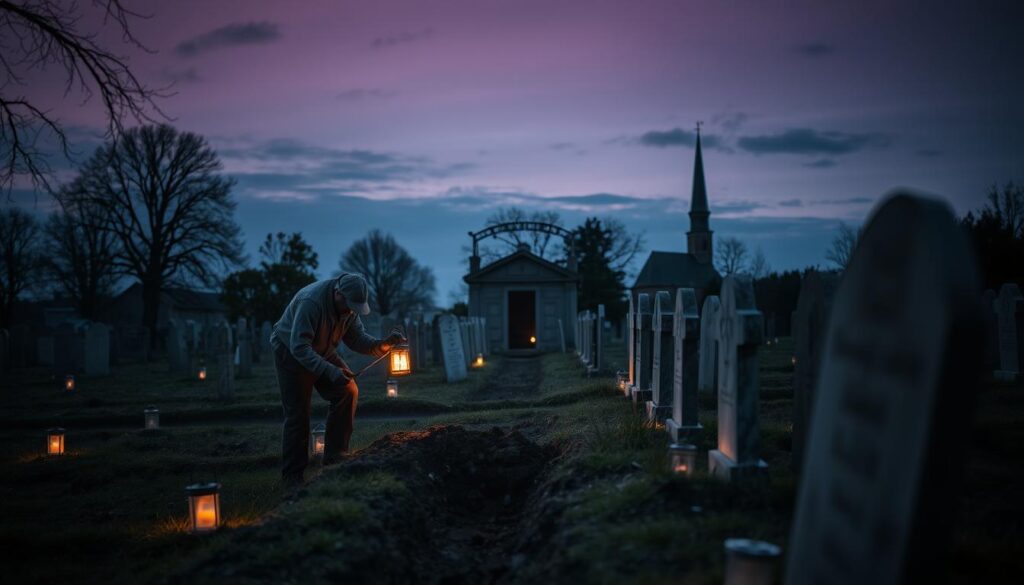Can a weathered and worn-out headstone be restored to its original glory? For families who have lost loved ones, a deteriorated cemetery monument can be a distressing sight. At our restoration service, we understand the emotional significance of these memorials.
We specialize in headstone restoration, using our expertise to revive the memories etched on these monuments. Our skilled team carefully assesses the damage and applies meticulous techniques to restore the headstone to its original state.
With our skilled approach, we not only repair the physical damage but also preserve the emotional value of these monuments. Our work ensures that the memories of the deceased are honored and respected.
Reviving Broken Headstones: Our Skilled Approach
Key Takeaways
- Expertise in headstone restoration and cemetery monument restoration
- Skilled team with meticulous restoration techniques
- Preservation of emotional value and memories
- Careful assessment and repair of damaged headstones
- Restoration to original state, honoring the deceased
The Significance of Cemetery Monument Preservation
Cemetery monument preservation is crucial for maintaining our cultural heritage and honoring the memories of our ancestors. These monuments serve as tangible links to our past, providing valuable insights into historical events, cultural practices, and the lives of our predecessors.
Historical and Cultural Heritage Value
Cemetery monuments are more than just markers of graves; they are historical documents that offer a window into the past. They reflect the art, culture, and societal values of their time, making them invaluable for historical and cultural research. By preserving these monuments through headstone repair services, we ensure that future generations can continue to learn from and appreciate their heritage.
The process of monument repair involves not just restoring the physical structure but also preserving the historical narrative it represents. This is particularly important for monuments made from materials like marble, granite, and sandstone, which are prone to deterioration over time.
Emotional Importance for Families and Descendants
Beyond their historical significance, cemetery headstones hold deep emotional value for families and descendants. They are often the last remaining connection to loved ones who have passed away, serving as a physical place for remembrance and reflection. Our cemetery headstone repair services are designed to be sensitive to this emotional aspect, ensuring that the restoration process respects the dignity and significance of the monument.
By preserving these monuments, we not only honor the memory of those interred but also provide a sense of continuity and connection for their families. This emotional importance underscores the need for professional and compassionate restoration services.
| Aspect | Historical Significance | Emotional Importance |
|---|---|---|
| Purpose | Preserves historical and cultural heritage | Honors the memory of loved ones |
| Beneficiaries | Historians, researchers, and the general public | Families and descendants of the interred |
| Impact | Maintains cultural identity and historical record | Provides a place for remembrance and reflection |
“The gravestones in our cemeteries are a tangible link to our past, a testament to the lives of those who came before us.”
Common Types of Headstone Damage We Encounter
Headstones are susceptible to various forms of damage, which our team encounters regularly during gravestone repair projects. Understanding these common types of damage is crucial for effective broken headstone repair and headstone maintenance.
Environmental Deterioration
Environmental factors play a significant role in the deterioration of headstones. Weathering, including rain, snow, and extreme temperatures, can cause erosion and cracking. Additionally, exposure to pollutants and acid rain can lead to the degradation of the stone surface.
- Chemical reactions between the stone and environmental pollutants
- Physical erosion due to wind and water
- Thermal stress from temperature fluctuations
Physical Breakage and Structural Issues
Physical damage is another common issue we encounter. This can result from accidents, natural disasters, or the settling of the ground over time. Structural integrity is compromised when headstones are broken or cracked, making stabilization a critical aspect of gravestone repair.
Biological Growth and Contamination
Biological growth, such as moss, lichen, and algae, can also damage headstones. These organisms can penetrate the stone, causing discoloration and surface degradation. Effective headstone maintenance involves removing these growths without damaging the stone.
Key considerations include:
- Assessing the type of biological growth
- Choosing appropriate cleaning methods
- Preventing future growth through protective treatments
By understanding these common types of damage, we can develop effective strategies for broken headstone repair and headstone maintenance, ensuring that monuments are preserved for future generations.
Our Professional Toolkit for Headstone Restoration
To ensure the longevity of restored headstones, we utilize a range of professional-grade materials and equipment. Our toolkit is carefully selected to address the unique challenges presented by various types of headstone damage.
Adhesives and Bonding Materials
The choice of adhesive is critical in headstone restoration. We use high-strength, weather-resistant bonding materials that are suitable for the specific type of stone being repaired. For instance, epoxy-based adhesives are often used for granite and marble headstones due to their durability and resistance to environmental degradation.
Specialized Cleaning Equipment
Cleaning is a delicate process that requires the right equipment to avoid damaging the headstone. We employ gentle yet effective cleaning solutions and soft-bristled brushes to remove dirt and biological growth without harming the stone. In some cases, we may use specialized laser cleaning technology to precision-clean intricate carvings or inscriptions.
- Soft-bristled brushes for gentle cleaning
- Low-pressure water jets for safe removal of debris
- Specialized cleaning solutions tailored to the type of stone
Safety and Protection Gear
Safety is paramount during the restoration process. Our team is equipped with personal protective equipment (PPE), including gloves, safety glasses, and masks, to protect against hazardous materials and ensure a safe working environment.
By combining the right tools with expert knowledge, we are able to restore headstones to their original condition, preserving the memories and legacy they represent.
Our Comprehensive Damage Assessment Protocol
Our team employs a rigorous damage assessment protocol to ensure that every headstone repair is done with precision and care. This thorough approach is crucial in cemetery headstone repair, where understanding the extent and nature of the damage is key to a successful restoration.
As we begin the assessment, we focus on Documentation and Photography Techniques. High-quality photographs are taken from multiple angles to capture the headstone’s condition, including any cracks, erosion, or biological growth. This visual documentation is complemented by detailed written records, noting the materials, dimensions, and any inscriptions or significant features.
Documentation and Photography Techniques
Accurate documentation is vital for planning the repair. Our team uses advanced photography techniques to capture detailed images, which are then used to analyze the condition of the headstone. This process helps in identifying the most appropriate headstone repair services required.

Structural Integrity Evaluation
Following documentation, we conduct a thorough Structural Integrity Evaluation. This involves assessing the stability and condition of the headstone, examining its foundation, and checking for any signs of structural failure. Our experts evaluate the extent of any damage, whether it’s due to environmental factors, physical breakage, or other causes, to determine the best approach for repairing broken headstones.
As emphasized by a leading conservator, “The assessment phase is critical because it informs the entire restoration process, ensuring that interventions are appropriate and effective.”
“The goal of conservation is to preserve the cultural heritage embodied in the monument, while making it accessible to the public.”
Customized Restoration Planning
The final step in our damage assessment protocol is Customized Restoration Planning. Based on the findings from our documentation and structural evaluation, we develop a tailored plan for the restoration. This plan outlines the specific techniques, materials, and treatments required to restore the headstone to its original condition, ensuring that it is both aesthetically pleasing and structurally sound.
By following this comprehensive protocol, we ensure that our cemetery headstone repair services are not only effective but also respectful of the monument’s historical and cultural significance.
Repairing Broken Headstones: Our Proven Methodology
With years of experience in gravestone repair, we have refined our process to address the unique challenges presented by each broken headstone. Our methodology is designed to ensure a durable and long-lasting repair that respects the original monument.
The first step in our repair process is the preparation of fractured surfaces. This involves carefully cleaning the broken areas to remove dirt, debris, or biological growth that could interfere with the repair. We use specialized techniques to prepare the surface for bonding, ensuring a strong and durable bond.
Preparation of Fractured Surfaces
Proper preparation of the fractured surfaces is crucial for a successful broken headstone repair. We meticulously clean and prepare the broken areas, removing any dirt or debris that may have accumulated. This step is essential for ensuring a strong bond between the fractured pieces.
- Careful cleaning of the broken areas
- Removal of dirt, debris, or biological growth
- Specialized surface preparation techniques
Professional Adhesive Application Techniques
Once the surfaces are prepared, we apply a professional headstone repair adhesive that is suitable for the type of stone involved. Our team is skilled in the application of these adhesives, ensuring that the bond is strong and durable. The choice of adhesive is critical, as it must be compatible with the stone and capable of withstanding environmental conditions.
We use a range of adhesives, each selected based on the specific requirements of the repair. Our expertise in adhesive application ensures a long-lasting bond that will withstand the elements.
Reinforcement and Stabilization Methods
In some cases, additional reinforcement may be necessary to stabilize the headstone. We employ various techniques to provide structural support, ensuring that the monument remains stable and secure. This may involve the use of internal pins or other stabilization methods, depending on the nature of the damage and the type of stone.
Our goal is to restore the headstone to its original condition, ensuring that it remains a lasting tribute to the deceased. Through our professional headstone repair services, we provide a valuable resource for families and cemetery administrators seeking to preserve historical monuments.
Material-Specific Restoration Approaches
Understanding the material composition of a headstone is crucial for effective restoration. Different materials present unique challenges and require specialized techniques. Our team has extensive experience in restoring headstones made from various materials, including marble, granite, limestone, and sandstone.
Marble Headstone Restoration
Marble headstones are particularly susceptible to weathering and erosion due to their calcium carbonate composition. Our restoration process for marble headstones involves gentle cleaning methods and the use of specialized adhesives to repair cracks and fractures. We also employ techniques to reattach detached fragments, ensuring the headstone’s structural integrity.
Granite Monument Repair
Granite monuments, while durable, can still suffer from damage over time. Our approach to granite repair focuses on using high-strength adhesives that can bond granite fragments securely. We also use precision techniques to realign and stabilize the monument, ensuring its longevity.
Limestone and Sandstone Preservation
Limestone and sandstone headstones are prone to deterioration due to their porous nature. Our preservation strategy for these materials includes careful cleaning to remove harmful biological growth and the application of protective treatments to prevent future damage. We also use consolidation techniques to strengthen the stone and prevent further decay.
By tailoring our restoration approaches to the specific material of each headstone, we ensure that our work is both effective and respectful of the original monument. Our goal is to preserve the integrity and appearance of the headstone, honoring the memory of those it commemorates.
Post-Repair Cleaning and Preservation Protocols
Our work doesn’t end with the repair; we also ensure that the headstone is properly cleaned and preserved. After restoring a headstone to its original state, it’s crucial to implement post-repair protocols to maintain its integrity and longevity.
To achieve this, we employ non-destructive cleaning methodologies that remove dirt and grime without damaging the headstone’s surface. This is particularly important for sensitive materials that can be easily harmed by harsh chemicals or abrasive techniques.
Non-Destructive Cleaning Methodologies
We utilize gentle cleaning solutions and soft-bristled brushes to clean the headstone. This approach ensures that the headstone is free from biological growth and other contaminants without sustaining any damage.
Biological Growth Remediation
Biological growth, such as moss, lichen, or mold, can be particularly challenging to remove. We use specialized treatments that target these organisms without harming the headstone material. Our treatments are designed to prevent future growth, ensuring the headstone remains clean and legible.
Protective Treatments and Sealants
To further protect the headstone, we apply protective treatments and sealants that repel water and reduce the risk of future damage. These treatments can significantly extend the life of the headstone, making it more resistant to environmental factors.
The following table summarizes our post-repair cleaning and preservation protocols:
| Protocol | Description | Benefits |
|---|---|---|
| Non-Destructive Cleaning | Gentle cleaning solutions and soft-bristled brushes | Preserves headstone surface, removes dirt and grime |
| Biological Growth Remediation | Specialized treatments for moss, lichen, and mold | Removes biological growth, prevents future growth |
| Protective Treatments and Sealants | Water-repelling treatments and sealants | Extends headstone life, reduces environmental damage |
By following these post-repair cleaning and preservation protocols, we ensure that our professional headstone repair work stands the test of time, maintaining the dignity and integrity of the memorial.
Navigating Legal and Ethical Considerations
Our team understands the importance of navigating legal and ethical considerations in cemetery headstone repair. Restoring monuments is not just about preserving the past; it’s also about respecting the present and future. This involves a multifaceted approach that includes obtaining necessary permissions, complying with historical preservation regulations, and being sensitive to cultural and religious practices.
Required Permissions and Documentation
Before commencing any headstone restoration work, we ensure that we have the necessary permissions and documentation. This may involve:
- Obtaining permission from cemetery authorities or property owners
- Reviewing historical records to understand the significance of the monument
- Documenting the condition of the headstone before and after restoration
Historical Preservation Compliance
We are committed to complying with historical preservation regulations that govern the repair and restoration of monuments. This includes using traditional techniques and materials where appropriate, and ensuring that our work is reversible to avoid altering the original character of the headstone.
Cultural and Religious Sensitivity
We recognize that monument repair often involves working with headstones that hold deep cultural or religious significance. We approach each project with sensitivity, respecting the beliefs and practices associated with the monument. This includes being mindful of rituals, symbols, and other elements that are important to the families or communities connected to the headstone.

Advanced Techniques for Severely Damaged Monuments
Restoring severely damaged monuments requires specialized expertise and advanced methodologies. Our team has developed a range of techniques to address complex restoration challenges.
Complex Reconstruction Methodologies
For monuments that are severely damaged, we employ complex reconstruction methodologies. This involves carefully dismantling the damaged structure, assessing each component, and rebuilding it using traditional techniques combined with modern materials.
Our experts are skilled in reconstructing intricate details and ensuring that the restored monument is both structurally sound and visually faithful to the original.
Structural Support Systems
In cases where the monument’s structural integrity is compromised, we implement structural support systems to ensure its stability. This may involve the use of internal reinforcement or the application of specialized adhesives to bond fractured elements.
Our team works closely with conservation experts to select the most appropriate support systems, ensuring that they are compatible with the monument’s materials and do not alter its appearance.
Replacement Considerations and Options
Sometimes, despite our best efforts, a monument may be beyond repair. In such cases, we consider replacement options that respect the original monument’s design and historical significance.
We work with clients to explore alternatives, such as creating a replica or finding a suitable replacement that honors the memory of the deceased, as part of our professional headstone repair services, which include repairing broken headstones and broken headstone repair.
Long-Term Maintenance Recommendations
To ensure the longevity of restored headstones, it’s crucial to implement a comprehensive maintenance plan. Regular upkeep not only preserves the aesthetic appeal but also maintains the structural integrity of the monument.
Seasonal Care Guidelines
Different seasons bring unique challenges to headstone maintenance. For instance, during winter, protecting the headstone from ice and snow is crucial, while in summer, shielding it from intense sunlight can prevent fading.
Regular cleaning is also essential; however, it’s vital to use appropriate methods and materials to avoid damaging the headstone.
Preventative Conservation Strategies
Preventative measures can significantly reduce the need for future repairs. This includes applying a protective sealant to the headstone to shield it from environmental elements.
Professional Inspection Schedule
Regular professional inspections are vital for identifying potential issues before they become major problems. We recommend scheduling inspections every 2-3 years, or more frequently in harsh environments.
| Maintenance Task | Frequency | Benefit |
|---|---|---|
| Cleaning | Quarterly | Prevents biological growth |
| Sealant Application | Every 5 years | Protects against environmental damage |
| Professional Inspection | Every 2-3 years | Identifies potential issues early |
Conclusion: Preserving Memorial Legacy Through Expert Restoration
Preserving the legacy of our loved ones is a noble endeavor, and expert headstone restoration plays a vital role in this process. Through our meticulous approach to monument repair and repairing broken headstones, we ensure that these memorials continue to honor the memories of those who have passed.
Our team is dedicated to delivering high-quality headstone restoration services that not only preserve the historical and emotional heritage of these monuments but also provide a lasting tribute to the individuals they commemorate. By entrusting us with the restoration of your loved one’s headstone, you can be confident that their memory will be preserved for generations to come.
With a focus on precision, care, and attention to detail, we strive to restore headstones to their original glory, ensuring that the stories and legacies they represent are never forgotten. Our commitment to excellence in headstone restoration and monument repair is unwavering, and we take pride in our work.
FAQ
What is the process for repairing a broken headstone?
We follow a meticulous process that involves assessing the damage, preparing the fractured surfaces, applying professional adhesive techniques, and reinforcing the headstone for stability. Our comprehensive damage assessment protocol ensures that we address all aspects of the damage.
How do you assess the damage to a headstone?
Our assessment involves thorough documentation, including photography techniques, evaluating the structural integrity of the headstone, and creating a customized restoration plan tailored to the specific needs of the monument.
What types of headstone materials can you restore?
We have expertise in restoring headstones made from various materials, including marble, granite, limestone, and sandstone. Each material requires a specific approach, and we are well-versed in the unique challenges and techniques associated with each.
Do you provide cleaning services after repairing a headstone?
Yes, we offer post-repair cleaning and preservation protocols, including non-destructive cleaning methodologies, biological growth remediation, and the application of protective treatments and sealants to ensure the longevity of the restoration work.
How do you ensure that your restoration work complies with historical preservation regulations?
We are committed to complying with historical preservation regulations and obtaining the necessary permissions and documentation required for the restoration project. We also respect cultural and religious practices associated with the monument.
Can you restore severely damaged monuments?
Yes, we have advanced techniques for restoring severely damaged monuments, including complex reconstruction methodologies, implementing structural support systems, and considering replacement options when necessary.
What maintenance recommendations do you provide for restored headstones?
We recommend seasonal care guidelines, preventative conservation strategies, and a professional inspection schedule to ensure the long-term integrity of the restored headstone.
Are your headstone repair services available for cemetery monuments?
Yes, we specialize in cemetery monument restoration and repair, and our services are designed to preserve the historical and emotional significance of these memorials.
How do you handle the restoration of headstones with biological growth or contamination?
We use specialized cleaning equipment and techniques to remediate biological growth and contamination, ensuring that the headstone is thoroughly cleaned and preserved.
Can you provide documentation of the restoration process?
Yes, we maintain detailed records of the restoration process, including before-and-after photographs, to document the work performed and ensure transparency throughout the project.




